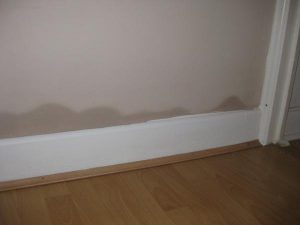Rising damp is one of the most common, but most dangerous problems in your home. As you can tell by its name, rising damp comes on slowly, rising up through the ground floor. It’s one of the three largest damp problems you’ll come across in the home. The other two are ‘penetrating damp’ and ‘condensation’. Each must be treated in different ways, and each show varying symptoms. Today, we’ll show you how to specifically identify rising damp.
Before we jump into the main chunk of the article, it’s worth understanding a little more about the problem. Rising damp occurs when water enters the walls of the ground floors. Now, most walls allow some water in. But, in most cases, the rising ground water is stopped by a damp proof course. That’s a long plastic, slate, or foam lining that blocks the route up through the walls. If this becomes ineffective, you will start to notice the early signs of rising damp. So what exactly are the early signs?
1. Damaged skirting boards
Water causes an immense amount of damage to wood, so that’s the first place you’ll notice a problem. The skirting boards are the lowest point in the rising pattern, so this is where you’ll see the first signs of trouble. Water slowly destroys skirting boards, turning them rotten. If you start to see the skirting boards crumbling and falling apart, it’s a sure sign that rising damp is taking hold.
2. Damaged floorboards
You’ll also notice a similar thing on your skirting boards. If the water damage spreads through the walls and into the flooring, then you’re looking at major repairs. Often, you’ll come across rising damp when the damp proof course is below the water line. (It can happen when houses sink slightly). At this point, you’ll see a lot of damage to the floorboards. If you aren’t sure about yours, take a look under the carpet, and look for signs of rotting.
3. Crumbling plaster and peeling paint
This symptom is one of the easiest ones to spot. It will be in your eyesight, and can happen at any point up the walls. You’ll begin to notice small bubbles in the paint or wallpapering. That’s the first sign of trouble. If you act now, you’ll certainly save yourself some money. If allowed to get worse, the paint will begin to peel away from the walls. The plaster itself may even start to crumble.
4. Tide marks and damp patches
As well as the peeling paint, you might also see visible tide lines. This is a mark of where the water has reached, and left a damp circle. The wall may even be wet to the touch. It’s also worth pointing out that this will all take place on the ground floor. If you’re seeing these symptoms on the first or second floor, it may suggest a different problem. In this case, it is more likely to be condensation (though be watchful for penetrating damp).
The earlier you spot these signs of trouble, the better! The longer rising damp is left to thrive, the more expensive the repair becomes.


 Damp Proofing
Damp Proofing Basement Damp Proofing
Basement Damp Proofing Water Damage
Water Damage Condensation Control
Condensation Control Dry Rot Treatment
Dry Rot Treatment WOODWORM & WET ROT
WOODWORM & WET ROT CAVITY Wall Ties
CAVITY Wall Ties Property Maintenance
Property Maintenance Waterproofing And Tanking
Waterproofing And Tanking Structural Repairs
Structural Repairs









It depends who you get in to do it and how slow/quick they are and how good a job they do, which takes time.There are alrosts of chancers out there painting and charging alrosts of different rates and with different levels of knowledge. So with that in mind you might get prices based on anything from a340 to a3200 per day. There’s no prizes for guessing who the trained decorators are and who was selling ice cream the week before.A time served city and guilds trained decorator is going to cost you between a3100-a3150 per day. He’ll be between three and ten times faster than the cheap person and know how to do a proper job that will last longer. You take your choice really. It will be cheaper if all the rooms can be done simultaneously, if they are empty etc. Depending on their condition, how much preparation you want etc. Without seeing them, it is up or down a little from 5 days work.
True! Pay cheap pay twice!
Rising damps look really dangerous for the home. I would be really scared to see something like this in the basement. The previous owners had told me that they had to flood in the past. We are hoping that this isn’t going to happen again but we will be prepared for it just in case.
Hi Charles. The best way to keep a property sound is to keep it dry. Regular maintenance is very important.
John
Hi Charles. No need to be scared call Tapco HomeDry :o)
Thanks for this great information on how to recognize rising damp! I’ve been noticing that our skirting boards seem to be falling apart in the house we just moved into, and I’m worried it might be an issue with rising damp. I’ll make sure to get someone to look at it before it starts to spread.
Hi Georgia, you’re very welcome, but make sure whoever looks at it is qualified and experienced. Rising Damp is not as common as most people are lead to believe, often the damp is being caused by another source such as high external ground levels or rain penetration. If the skirting boards are falling apart it is possible that the problem has been there a long while and could turn to Dry Rot. Have it checked out by a reputable company or an independent timber and damp surveyor as soon as possible.
Hi Georgia. You are very welcome, hopefully it helped. We have just posted a new blog which you might also find useful.
Thanks for the sharing such a informative post, Rising damp can be really dangerous, and drastically effect the value of your home.